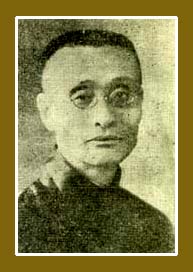Views
Jiǎng Wéiqiáo 蔣維喬 (1873-1958)
|
| Notable Associates: |
|
Jiǎng Wéiqiáo 蔣維喬 (1873-1958)
An important educator, politician, and lay Buddhist of the Republican period. He was also a seminal figure in the development of modern qìgōng 氣功.
Biography:
In 1892, Jiǎng received his xiūcái 秀才 degree. After getting his degree, he became familiar with the scientific and technical translations produced by the Jiangnan Arsenal 江南機器製造總局, which caused him to become increasingly interested in Western Learning 西學. In 1895, he tested into the Nánqīng Academy 南菁書院 in Jiāngyīn 江陰. One of his classmates there was Dīng Fúbǎo 丁福保.
In 1902, he arrived in Shànghǎi 上海 to participate in the Chinese Education Association 中國教育會, set up by Cài Yuánpéi 蔡元培. Other participants included Wáng Xiǎoxú 王小徐.
With the establishment of the Republic in 1912, Cài became head of the new Ministry of Education, and Jiǎng served as Secretary under him. In April, they moved from Nánjīng to Běijīng. Because of various upheavals in the government, he quit and returned to Shànghǎi in October, 1913. There, he took a job as chief editor of the textbooks division of the Commercial Press 商務印書館.
In 1914, Jiǎng published Master Yīnshì's Meditation Method 因是子靜坐法, in which he tried to establish a qìgōng 氣功 scheme on scientific grounds. For this reason, he is often cited as one of the fathers of modern qìgōng. Jiǎng's book was heavily based on the book Mr. Okada's Meditation Method 岡田氏靜坐法" by the Japanese author Okada Torajirō 岡田虎二郎 (1872-1920).[1]
Jiǎng began working for the Ministry of Education again in July, 1917. That year, he was part of a team doing an audit of educational systems in East Asia. They first went to Japan and the Philippines, before traveling around China investigating the nation's educational institutions. Around this time, Jiǎng got to know Xú Wèirú 徐蔚如, who was the chief of accounting for the government. Xú had recently converted to Buddhism, and under his influence Jiǎng began to study Buddhism seriously. He studied on his own,, as well as with Táng Dàyuán 唐大圓. Jiǎng and Xú also studied Consciousness-Only with Zhāng Kèchéng 張克誠 at Guǎngjì Temple 廣濟寺 in Běijīng.
In March of 1918, Dìxián 諦閑 came to Běijīng to lecture on the Sūtra of Perfect Awakening 圓覺經, which Jiǎng and others recorded, and which was eventually published as 圓覺經親聞記. At this time Jiǎng, Xú, and others took refuge under Dìxián. Also in 1918, Jiǎng began teaching a course on Consciousness-Only in the Philosophy Department at Běijīng University.
Jiǎng met Tàixū 太虛 in 1921, and studied Buddhist logic with him.
In 1925, Jiǎng began teaching at Southeastern University 東南大學 in Nánjīng, which had recently had its name changed from Nanjing Normal High School 南京高等師範學堂 by its president Jiāng Yìyuán 江易園. There he taught introductory courses on Buddhism as an academic subject.
Between 1929 and 1949, Jiǎng taught at a number of colleges in and around Shànghǎi.
In 1949, he was elected chairman of the people's representative body for Southern Jiāngsū.
Major Works:
- A History of Chinese Buddhism 中國佛教史, 1929. This was based on on 支那仏教史綱 by Sakaino Satoru 境野哲 published in 1907. It was revised and republished by Huáng Chànhuá 黃懺華 in 1940.
- Master Yīnshì's Meditation Method 因是子靜坐法. Commercial Press, 1914. This book was based on Okada Torajirō's 岡田虎二郎 (1872-1920) book 岡田氏靜坐法.
- 大乘廣五蘊論註
- 佛學概論
- 佛學綱要
- 中國近三百年哲學史
- 中國哲學史綱要
Notes:
- ↑ See Otehode, 243-244.
References:
- Otehode, Utiraruto. “The Creation and Reemergence of Qigong in China.” Yoshiko Ashiwa and David L. Wank, eds. Making Religion, Making the State: The Politics of Religion in Modern China. Stanford: Stanford University Press, 2009. Pp. 241-265.
- Shì Dōngchū 釋東初. Zhōngguó Fójiào jìndài shǐ 中國佛教近代史 (A History of Early Contemporary Chinese Buddhism), in Dōngchū lǎorén quánjí 東初老人全集 (Complete Collection of Old Man Dongchu), vols. 1-2. Taipei: Dongchu, 1974 Pp. 2.699-701.
- Yú Língbō 于凌波, ed. Xiàndài Fójiào rénwù cídiǎn 現代佛教人物辭典 (A Dictionary of Modern Buddhist Persons), 2 vols. Taipei: Foguang, 2004. Pp. 2.1580a-1582b.
